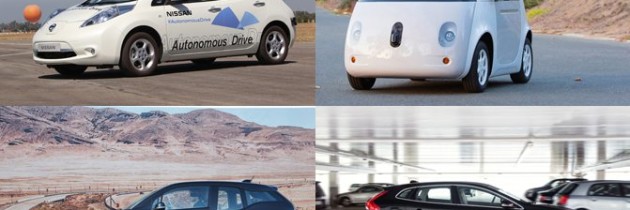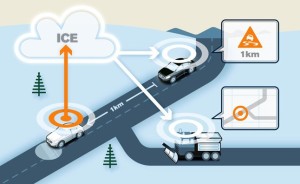When Will Self-Driving Cars Really Arrive?
Original article can be read at autoguide.com
Does the self-driving car have a realistic due date? Many automakers and industry analysts are pegging autonomous cars to hit the mass market within a decade, but their predictions are often inconsistent with each other.
It’s the self-driving dream of the future: you take your hands off the wheel during heavy traffic or a boring highway drive and get on your mobile phone or tablet. Maybe you’re about to get a head start on some work or message your friends. While you do that, your car manages the rest of the commute home, meaning you don’t have to deal with the monotony or frustration of driving in traffic.
“We definitely have the technology for it now,” says Andrew Poliak from automotive technology supplier QNX. “We expect self-driving cars to be a mainstream thing between 2020 and 2025.”
Poliak lists a number of semi-autonomous features currently available in vehicles that make certain driving tasks much easier. Some of today’s cars can park themselves, stay in their lanes, mitigate accidents, or maintain a set distance from a vehicle in front. QNX believes that these driver assistance features will spread to many more vehicles by 2018, and be a jumping off point for fully autonomous cars. Many of these features can already be found in affordable, mainstream cars.
But still, despite the fact that the technology is already here, Poliak points out a number of reasons why mainstream autonomous vehicles won’t be ready for another five to 10 years.
COSTS
“Cost is one of the biggest obstacles to overcome when it comes to bringing autonomous features to mainstream cars,” he says. “LiDAR (a method of measuring distances and mapping environments) is big and expensive, but in the next few years, they’ll get smaller and more affordable.” Poliak even explains that there are some plans to integrate those sensors into the headlight of a car, making them sleek in terms of design. As of now, they look like silly cones or hats on top of the vehicles.
See also: Google’s Self-Driving Car Heading to Public Streets
CONNECTIVITY
“Connectivity will need to be a big thing for autonomous cars,” he says. “When it comes to navigating a route, the car will need the most accurate map information including traffic data, road closures and weather conditions.” Having an integrated internet connection will help provide the car with this kind of news. While a few cars like those from GM and BMW already have some kind of wireless connectivity, the features and usefulness of such a connection hasn’t been fully exploited to this degree yet.
“And you’ll need a lot of really accurate map data,” adds Poliak. He points out that even modern navigation systems can get confused about what lane you’re in when passing an exit ramp on the highway. What’s a simple annoyance in a modern car may be a serious problem in a self-driving car. More accurate maps will help eliminate that problem.
See also: Michigan Opens Fake City for Testing Driverless Cars
Vehicles will need to connect and communicate with one another and with the world around them. This kind of connectivity can help self-driving cars with things like identifying where there’s a lot of traffic (and if they can avoid it) or how to save fuel by timing a stop light.
ACCEPTANCE
Another obstacle in the way of self-driving cars is whether people actually want them or not. Many recent studies show that consumers are not ready just yet to trust driverless car technology.
“One of the things that will slow down adoption is the wants and desires of the consumer,” says Poliak. “There’s a generation of consumers who want to be working or on social media instead of driving, and then there’s another generation who still enjoys driving.”
See also: Most Adults ‘Worried’ About Riding in Driverless Cars: Study
Of course, the introduction of self-driving vehicles will disrupt a lot of the automotive and transportation industries. A self-driving Mercedes truck concept practically signalled the end of the road for transport drivers.
“When it comes to these delivery trucks, every pound of weight they shave results in pretty significant fuel savings and less cost to operate,” said Poliak, suggesting that self-driving trucks could exist without operators and make more money for their company.
Poliak even mused that maybe consumer cars could act like Uber when you don’t need them, earning fares as a taxi.
SAFETY
Finally, self-driving cars have to be really safe before they become more mainstream.
“Safety is all about security,” he said. QNX operating systems are used in some of the most important computers around the world, and are found in everything from nuclear power plants to medical applications. They’re always expected to be reliable and responsive and have earned that exact reputation.
“This isn’t like a PC that can be updated and patched all the time,” he said, meaning that the artificial intelligence behind a self-driving car needs to be bulletproof from the get-go.
Furthermore, in order to improve cybersecurity between cars, the National Highway Traffic Safety Administration (NHTSA) has been working with automakers to figure out how to ensure that all the communication between cars and infrastructure are properly secured.
LEGAL OBSTACLES
Another obstacle facing autonomous cars is the legal issues surrounding them. Governments are scrambling to write legislation to catch up with autonomous car development to answer questions relating to safety and liability. Who is liable when an autonomous car crashes? Who will program the cars to make life and death decisions? What are the safety standards driverless cars must meet? These questions must be answered before we have a viable environment to have self-driving vehicles.
THE ROAD MAP
Automakers mostly agree with QNX’s timeframe of driverless cars becoming mainstream by 2020 to 2025. Nissan is looking to introduce autonomous vehicles in the year 2020 that will have the ability to navigate in many situations, including city driving, which is commonly seen as being the most complex place for a self-driving car. That’s because it incorporates cars, bikers, pedestrians and other obstacles.
In order to meet this timeframe, Nissan has its own research center in Silicon Valley, and is even partnering with NASA to jointly develop autonomous vehicles by 2020. Nissan makes sure to point out that its self-driving vehicles will still need someone in them and that a truly driverless car that you can order around may be a decade away.
Volvo is also hard at work on self-driving cars, with plans to sell 100 autonomous XC90 SUVs in the year 2017 as part of a pilot project. The SUVs will only be able to run without driver intervention on a specific 31-mile piece of highway. These customers will be among the first in the world to actually be able to use a fully autonomous driving system on public roads.
The future is exciting for new automotive technology. While semi-autonomous driver assistance features are already growing in popularity, the next five years will see more autonomously operated vehicles so long as certain obstacles are cleared.





